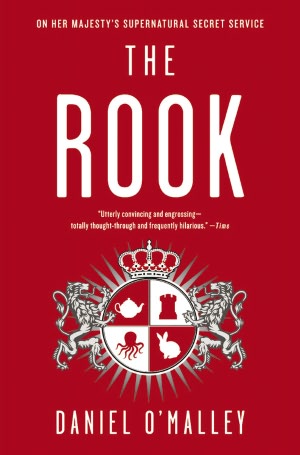 Daniel O’Malley’s first novel, The Rook, won the 2012 Aurealis Award for best SF Novel published by an Australian and comes laden with praise from writers like Charlaine Harris, Charles Yu and Lev Grossman. I found it hard to understand why.
Daniel O’Malley’s first novel, The Rook, won the 2012 Aurealis Award for best SF Novel published by an Australian and comes laden with praise from writers like Charlaine Harris, Charles Yu and Lev Grossman. I found it hard to understand why.
The Rook is the story of Myfanwy Thomas, holder of the eponymous title in the secret Checquy – an ancient agency of the British government that rolls up the roles of GCHQ, the SAS, MI5, MI6 and more and is tasked with the job of clobbering anything supernatural that threatens the interests of the British state. The story begins as Myfanwy comes to her senses in an unnamed London park. She has no memories. Her only clue about who she is and what has happened comes in the form of a letter in her pocket – written by herself.
The story that unfolds is of treachery in the heart of the Checquy and the return of a long-feared (Belgian!?!) threat determined to have revenge for a centuries-old humiliation.
O’Malley is not aspiring to high art. The Rook seeks to be an action-driven, lightly comic adventure. This is a noble enough aim. It is too easy to dismiss the craft required to construct a tightly told story that propels the reader through the text. The art of comedy is even more frequently overlooked but even more difficult to write. What each of us finds funny is an intensely personal sensibility but really good comedy must also find a way to touch some (near) universal nerve.
Even judging it on its own terms, however, The Rook fails.
Amnesia is a dull, well-worn, trick for an author to play on his protagonist but that doesn’t mean the results couldn’t have added something to this story. What is inexplicable is that O’Malley, having introduced this tired trope, throws it away by giving Myfanwy a giant folder full of information on her history. He thus instantly dissipates most of the dramatic possibilities in his protagonist’s awkward position and, more egregiously, he also destroys any chance that his story will develop the velocity essential in this type of book.
The folder becomes the pretext for long, long passages of info-dumping and each time it protrudes into the novel the story stops dead. Much of this material could easily have been excised, and what remained would have been a leaner, more exciting and more satisfying novel.
Another problem is the fact that the novel lacks any sense of physical place. Locations are mentioned – London, Bath, Reading, a Welsh valley, a Scottish castle – but they are only names and there is no indication that the author knows or cares what these places are really like. Descriptions are, at best, sketchy. One major piece of action takes place around Reading police station, which we learn is a “large building” (378) with wooden doors that have windows (397) and steps to the front door (405). Even allowing for the author’s inability to conjure a convincing imaginary alternative, in the age of Google Maps there is no excuse for such vagueness.
Too much of The Rook takes place amidst grey shadows that the author expects the reader to autocomplete from a shared palate of stock settings.
As for the comedy, I laughed out loud once on page 140 at a line about men in hats. Others may have better luck, though it will depend on whether you find the name Myfanwy funny. In his acknowledgments, O’Malley thanks his “editrix” for the entertaining debates “such as what color of fungus was funnier” (they went with purple) but I think both author and reader would have been better served by a more ruthless approach with the red pen.